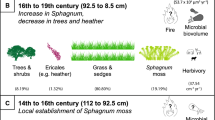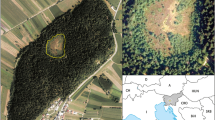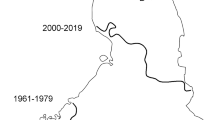Abstract
For ecosystems perceived as degraded, but for which the causal factors or timescales for the degradation are disputed or not known, long-term (palaeo-)ecological records may aid understanding and lead to more meaningful conservation approaches. To help ‘bridge the gap’ between (very) long-term ecology and contemporary ecology for practical application, there have been calls for working relationships to be established between palaeoecologists and conservation ecologists. One environment in which this has been attempted is blanket mire. Many blanket mires in Europe are degraded and contain few sphagna. In South Wales, almost all exhibit symptoms of degradation, with dominance by purple moor grass (Molinia caerulea) widespread. We used palaeoecological techniques on three peat profiles in the Brecon Beacons to investigate vegetation history of high-altitude blanket mire to help assess the relative contribution of various factors in mire degradation and to inform strategies for mire conservation and restoration management. We found that declines in sphagna preceded the rise to dominance of monocotyledons. Macrofossil records showed that although Molinia was already present on the Beacons before the start of the industrial revolution, its major rise to dominance in one profile was within the 20th Century, coincident with evidence for local fire. In another profile, it was out-competed by Eriophorum vaginatum after the start of the industrial revolution; there is circumstantial evidence to suggest that a reduction in burning contributed to the rise in E. vaginatum. Conservation management to reduce the current local dominance of both Eriophorum and Molinia is supported by the palaeoecological data, but severe erosion and hagging of peat will constrain practical methods for achieving this on the Beacons until the peat is stabilised. We suggest that palaeoecological techniques have wider applicability in conservation.










Similar content being viewed by others
References
Birks HJB (1996) Contributions of Quaternary palaeoecology to nature conservation. J Veg Sci 7:89–98
Blackford JJ, Chambers FM (1993) Determining the degree of peat decomposition for peat-based palaeoclimatic studies. Int Peat J 5:7–24
Bradshaw EG, Rasmussen P, Odgaard BV (2005) Mid- to late-Holocene land-use change and lake development at Dallund S0, Denmark: synthesis of multiproxy data, linking land and lake. Holocene 15:1152–1162
Bunting MJ (2008) Bridging the Gap: Newsletter 1 http://www2.hull.ac.uk/science/pdf/geogmjbNewsletter1_0508.pdf Accessed 15 May 2012
Bunting MJ, Whitehouse NJ (2008) Editorial: adding time to the conservation toolkit: palaeoecology and long term wetland function dynamics. Biodivers Conserv 17:2051–2054
Chambers FM (1982) Two radiocarbon-dated pollen diagrams from high-altitude blanket peats in South Wales. J Ecol 70:445–459
Chambers FM, Daniell JRG (2011) Conservation and habitat restoration of moorland and bog in the UK uplands: a regional, paleoecological perspective. PAGES Newslett 19(2):45–47
Chambers FM, Lageard JGA (1997) Palaeoenvironmental analyses of peat samples from Pen-y-fan, Corn-dû and Tommy Jones’s Pillar. In: Gibson A, Erewood C, Coombs D, Robinson M, Caseldine A, Barrow C, Chambers F, Lageard J (eds) Survey, excavation and palaeoenvironmental investigations on Pen-y-fan and Corn-dû. Brecon Beacons, Powys, 1990–1992. Studia Celtica XXXI:1–81
Chambers FM, Dresser PQ, Smith AG (1979) Radiocarbon dating evidence on the impact of atmospheric pollution on upland peats. Nature 282:829–831
Chambers FM, Mauquoy D, Todd PA (1999) Recent rise to dominance of Molinia caerulea in environmentally sensitive areas: new perspectives from palaeoecological data. J Appl Ecol 36:719–733
Chambers FM, Mauquoy D, Cloutman EW, Daniell JRG, Jones PS (2007a) Recent vegetation history of Drygarn Fawr (Elenydd SSSI), Cambrian Mountains, Wales: implications for conservation management of degraded blanket mires. Biodivers Conserv 16:2821–2846
Chambers FM, Mauquoy D, Gent A, Pearson F, Daniell JRG, Jones PS (2007b) Palaeoecology of degraded blanket mire in South Wales: data to inform conservation management. Biol Conserv 137:197–209
Chambers FM, Beilman DW, Yu Z (2011a) Methods for determining peat humification and for quantifying peat bulk density, organic matter and carbon content for palaeostudies of climate and peatland carbon dynamics. Mires and Peat 7:Article 07, 1–10
Chambers FM, van Geel B, van der Linden M (2011b) Considerations for the preparation of peat samples for palynology, and for the counting of pollen and non-pollen palynomorphs. Mires and Peat 7:Article 11, 1–14
Clapham AR, Tutin TG, Moore DM (1987) Flora of the British Isles, 3rd edn. Cambridge University Press, Cambridge
Davies AL (2010) Palaeoecology, management, and restoration in the Scottish Highlands. In: Hall M (ed) Restoration and history: the search for a useable environmental past. Routledge, Abingdon, pp 74–86
Davies AL, Bunting MJ (2010) Applications of palaeoecology in conservation. The Open Ecol J 3:54–67. doi:10.2174/1874213001003020054
De Vleeschouwer F, Chambers FM, Swindles GT (2010a) Coring and sub-sampling of peatlands for palaeoenvironmental research. Mires and Peat 7:Article 01, 1–10
De Vleeschouwer F, Hughes PDM, Nichols JE, Chambers FM (2010b) A review of protocols in peat palaeoenvironmental studies. Mires and Peat 7:Article 00, 1–9
Elkington T, Dayton N, Jackson DL, Strachan IM (2002) National Vegetation Classification field guide to mires and heaths. JNCC, Peterborough, pp 120
Faegri K, Iversen J (1989) Textbook of pollen analysis, 4th edn. Wiley, Chichester, p 328
Froyd CA, Willis KJ (2008) Emerging issues in biodiversity and conservation management: the need for a palaeoecological perspective. Quaternary Sci Rev 27:1723–1732
Grimm E (1991) TILIA and TILIAGRAPH. Illinois State Museum, Springfield, Illinois
Guile DPM (1965) The vegetation of the Brecon Beacons National Park. Unpub. PhD thesis, University of Wales, Cardiff
Gustavsson E, Lennartsson T, Emanuelsson M (2007) Land use more than 200 years ago explains current grassland plant diversity in a Swedish agricultural landscape. Biol Conserv 138:47–59
Immirzi P, Meade R, Ramsay D (1997) The way forward: a manifesto for blanket mires. In: Tallis JH, Meade R, Hulme PD (eds) Blanket mire degradation: causes, consequences and challenges. Macaulay Land Use Research Institute, Aberdeen, pp 205–209
JNCC (Joint Nature Conservation Committee) (2007) Conservation status assessment for H7130: blanket bogs. Second report by the UK under Article 17 on the implementation of the Habitats Directive from January 2001 to December 2006. JNCC, Peterborough
Jones PS (2003) Blanket bog. In: Jones PS, Stevens DP, Blackstock TH, Burrows CR, Howe EA (eds) Priority habitats of Wales: a technical guide. Countryside Council for Wales, Bangor, pp 93–97
Lageard JGA, Chambers FM, Grant ME (1994) Modified versions of a traditional peat-cutting tool to improve field sampling of peat monoliths. Quaternary Newslett 74:10–15
Leigh RA, Johnston AE (eds) (1994) Long-term experiments in agricultural and ecological sciences. CAB International, Wallingford
Lindsey RA (1995) Bogs: the ecology, classification and conservation of ombrotrophic mires. Scottish Natural Heritage, Battleby
Marrs RH, Phillips JDP, Todd PA, Ghorbani J, Le Duc MG (2004) Control of Molinia caerulea on upland moors. J Appl Ecol 41:398–411
Mauquoy D, Hughes PDM, van Geel B (2010) A protocol for plant macrofossil analysis of peat deposits. Mires and Peat 7:1–5
Piotrowska N, Blaauw M, Mauquoy D, Chambers FM (2011) Constructing deposition chronologies for peat deposits using radiocarbon dating. Mires and Peat 7:1–14
Rasmussen P (2005) Mid- to late-Holocene land-use change and lake development at Dallund S0, Denmark: vegetation and land-use history inferred from pollen data. Holocene 15:1116–1129
Rodwell JS, Pigott CD, Ratcliffe DA, Malloch AJC, Birks HJB, Proctor MCF, Shimwell DW, Huntley JP, Redford E, Wigginton MJ, Wilkins P (1991) British plant communities: mires and heaths. Cambridge University Press, Cambridge
Rose NL, Appleby PG (2005) Regional applications of lake sediment dating by spheroidal carbonaceous particle analysis I: United Kingdom. J Paleolimnol 34:349–361
Simmons IG (2003) The moorlands of England and Wales. Edinburgh University Press, Edinburgh
Smith AG, Cloutman EW (1988) Reconstruction of Holocene vegetation history in three dimensions at Waun-Fignen-Felen, an upland site in South Wales. Philos T Roy Soc B 322:159–219
Stuiver M, Pearson GW (1993) High-precision bidecadal calibration of the radiocarbon timescale, AD 1950–500 BC and 2500–6000 BC. Radiocarbon 35:1–23
Swindles GT (2010) Dating recent peat profiles using spheroidal carbonaceous particles (SCPs). Mires and Peat 7:Article 3, 1–5
Tallis JH (1985) Mass movement and erosion of a southern pennine blanket peat. J Ecol 73:283–315
Tallis JH (1997a) Peat erosion in the Pennines: the badlands of Britain. Biologist 44:277–279
Tallis JH (1997b) The pollen record of Empetrum nigrum in Southern Pennine peats: implications for erosion and climate change. J Ecol 85:455–465
Tallis JH (1997c) The Southern Pennine experience: an overview of blanket mire degradation. In: Tallis JH, Meade R, Hulme PD (eds) Blanket mire degradation: causes, consequences and challenges. Macaulay Land Use Research Institute, Aberdeen, pp 7–15
Tallis JH, Meade R, Hulme PD (eds) (1997) Blanket mire degradation: causes, consequences and challenges. Macauley Land Use Research Institute, Aberdeen
Tansley AG (1939) The British Isles and their vegetation, 2 vols. Cambridge University Press, Cambridge
van der Plicht J, Yeloff D, van der Linden M, van Geel B, Brain S, Chambers FM, Webb J, Toms P (2013) Dating recent peat accumulation in European ombrotrophic bogs. Radiocarbon 55 (in press)
van Leeuwen JFN, Froyd CA, van der Knaap WO, Coffey EE, Tye A, Willis KJ (2008) Fossil pollen as a guide to conservation in the Galápagos. Science 322:1206
Willis KJ, Birks HJB (2006) What is natural? The need for a long-term perspective in biodiversity conservation. Science 314:1261–1265
Willis KJ, Gillson L, Brncic TM (2004) How “virgin” is virgin rainforest? Science 304:402–403
Willis KJ, Bailey RM, Bhagwat SA, Birks HJB (2010) Biodiversity baselines, thresholds and resilience: testing predictions and assumptions using palaeoecological data. Trends Ecol Evol 25:583–591
Yeo M (1997) Blanket mire degradation in Wales. In: Tallis JH, Meade R, Hulme PD (eds) Blanket mire degradation: causes, consequences and challenges. Macaulay Land Use Research Institute, Aberdeen, pp 101–115
Acknowledgments
The field and lab-based research was commissioned by the Countryside Council for Wales as part of contract no. FC 73-01-172. Site access was granted by The National Trust, Wales. Caro McIntosh drew an earlier version of Fig. 1.
Author information
Authors and Affiliations
Corresponding author
Rights and permissions
About this article
Cite this article
Chambers, F.M., Cloutman, E.W., Daniell, J.R.G. et al. Long-term ecological study (palaeoecology) to chronicle habitat degradation and inform conservation ecology: an exemplar from the Brecon Beacons, South Wales. Biodivers Conserv 22, 719–736 (2013). https://doi.org/10.1007/s10531-013-0441-4
Received:
Accepted:
Published:
Issue Date:
DOI: https://doi.org/10.1007/s10531-013-0441-4




